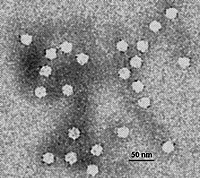
Photo from wikipedia
Background. Sepsis and the ensuing immune dysfunction continue to be major contributors to neonatal morbidity and mortality. Neonatal sepsis also is associated with profound immune dysfunction. We have recently identified… Click to show full abstract
Background. Sepsis and the ensuing immune dysfunction continue to be major contributors to neonatal morbidity and mortality. Neonatal sepsis also is associated with profound immune dysfunction. We have recently identified a role for a family of coinhibitory molecules that are altered in murine sepsis and in critically ill adult patients, which may be a target for development of novel therapies. There is, however, a paucity of data pertaining to the role of coinhibitory checkpoint proteins in the control and modulation of neonatal sepsis. Methods. The cecal slurry model consists of harvesting the cecal content of an adult, wild‐type, male mouse and combining it with 5% dextrose to create a cecal slurry with a concentration of 80 mg/mL (LD70 at 7 days). Neonatal mice (5–7 days of age) underwent intraperitoneal injection of the cecal slurry or 0.9% saline for the sham procedure. Wild‐type (C57BL/6) or PD‐1‐/‐ mice were used; a 7‐day survival study was undertaken. Cytometric bead array was used for cytokine expression. Blood and peritoneal fluid was cultured for bacterial burden. Flow cytometry was used to assess the peritoneal cavity cell populations. Results. There was no mortality after the sham procedure in either wild‐type or PD‐1‐/‐ pups. PD‐1 markedly affected sepsis survival with significantly improved survival in the PD‐1‐/‐ pups (40% vs 80%; P < .01). This survival improvement was not associated with any difference in bacterial clearance. The bacterial burden was equivalent between wild‐type and PD‐1‐/‐ pups at 24 hours after cecal slurry. However, PD‐1‐/‐ pups did display an increased circulating cytokine response to the cecal slurry compared with wild type, with increased expression of IL‐6, IL‐10, and TNF‐&agr; levels. Within the peritoneal cavity, sepsis induced an influx of neutrophils, a finding that was increased in PD‐1‐/‐ pups. Although the T‐cell response was unaffected by PD‐1, it was noted that cecal slurry induced a loss of peritoneal B cells in WT, while the peritoneal B‐cell population was preserved in PD‐1‐/‐ pups. Conclusion. Our data suggest that the checkpoint protein, PD‐1, plays an important role in controlling the immune response to sepsis in the neonate, ultimately affecting sepsis‐related mortality in this neonatal murine model of sepsis. Akin to adult studies, these data further emphasize the potential therapeutic target for PD‐1 across a spectrum of septic patients.
Journal Title: Surgery
Year Published: 2017
Link to full text (if available)
Share on Social Media: Sign Up to like & get
recommendations!